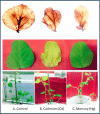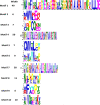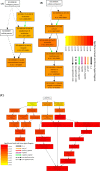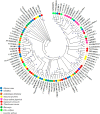Impact of Some Toxic Metals on Important ABC Transporters in Soybean (Glycine max L.)
- PMID: 37546587
- PMCID: PMC10399161
- DOI: 10.1021/acsomega.3c03325
Impact of Some Toxic Metals on Important ABC Transporters in Soybean (Glycine max L.)
Abstract
In plants, ATP-binding cassette (ABC) transporters facilitate the movement of substrates across membranes using ATP for growth, development, and defense. Soils contaminated with toxic metals such as cadmium (Cd) and mercury (Hg) might adversely affect the metabolism of plants and humans. In this study, a phylogenetic relationship among soybeans' (Glycine max) ATP binding cassette (GmABCs) and other plant ABCs was analyzed using sequence information, gene structure, chromosomal distribution, and conserved motif-domain. The ontology of GmABCs indicated their active involvement in trans-membrane transport and ATPase activity. Thirty-day-old soybean plants were exposed to 100 μM CdCl2 and 100 μM HgCl2 for 10 days. Physiological and biochemical traits were altered under stress conditions. Compared to Control, GmABC transporter genes were differentially expressed in response to Cd and Hg. The qRT-PCR data showed upregulation of seven ABC transporter genes in response to Cd stress and three were downregulated. On the other hand, Hg stress upregulated four GmABC genes and downregulated six. It could be concluded that most of the ABCB and ABCG subfamily members were actively involved in heavy metal responses. Real-time expression studies suggest the function of specific ABC transporters in Cd and Hg stress response and are helpful in future research to develop stress-tolerant varieties of soybean.
© 2023 The Authors. Published by American Chemical Society.
Conflict of interest statement
The authors declare no competing financial interest.
Figures










Similar articles
-
Exploring the role of ATP-binding cassette transporters in tomato (Solanum lycopersicum) under cadmium stress through genome-wide and transcriptomic analysis.Front Plant Sci. 2025 Mar 18;16:1536178. doi: 10.3389/fpls.2025.1536178. eCollection 2025. Front Plant Sci. 2025. PMID: 40171483 Free PMC article.
-
In Silico Genome-Wide Analysis of the ATP-Binding Cassette Transporter Gene Family in Soybean (Glycine max L.) and Their Expression Profiling.Biomed Res Int. 2019 Jan 10;2019:8150523. doi: 10.1155/2019/8150523. eCollection 2019. Biomed Res Int. 2019. PMID: 30766888 Free PMC article.
-
Genome-Wide Identification of Soybean ABC Transporters Relate to Aluminum Toxicity.Int J Mol Sci. 2021 Jun 18;22(12):6556. doi: 10.3390/ijms22126556. Int J Mol Sci. 2021. PMID: 34207256 Free PMC article.
-
Genome-wide identification of ATP binding cassette (ABC) transporter and heavy metal associated (HMA) gene families in flax (Linum usitatissimum L.).BMC Genomics. 2020 Oct 19;21(1):722. doi: 10.1186/s12864-020-07121-9. BMC Genomics. 2020. PMID: 33076828 Free PMC article. Review.
-
Advances in Genes-Encoding Transporters for Cadmium Uptake, Translocation, and Accumulation in Plants.Toxics. 2022 Jul 22;10(8):411. doi: 10.3390/toxics10080411. Toxics. 2022. PMID: 35893843 Free PMC article. Review.
Cited by
-
Exploring the role of ATP-binding cassette transporters in tomato (Solanum lycopersicum) under cadmium stress through genome-wide and transcriptomic analysis.Front Plant Sci. 2025 Mar 18;16:1536178. doi: 10.3389/fpls.2025.1536178. eCollection 2025. Front Plant Sci. 2025. PMID: 40171483 Free PMC article.
-
Haplotypes of ATP-Binding Cassette CaABCC6 in Chickpea from Kazakhstan Are Associated with Salinity Tolerance and Leaf Necrosis via Oxidative Stress.Biomolecules. 2024 Jul 10;14(7):823. doi: 10.3390/biom14070823. Biomolecules. 2024. PMID: 39062537 Free PMC article.
References
-
- Verrier P. J.; Bird D.; Burla B.; Dassa E.; Forestier C.; Geisler M.; Klein M.; Kolukisaoglu U.; Lee Y.; Martinoia E.; Murphy A.; Rea P. A.; Samuels L.; Schulz B.; Spalding E. P.; Yazaki K.; Theodoulou F. L. Plant ABC proteins-a unified nomenclature and updated inventory. Trends Plant Sci. 2008, 13, 151–159. 10.1016/j.tplants.2008.02.001. - DOI - PubMed
LinkOut - more resources
Full Text Sources
